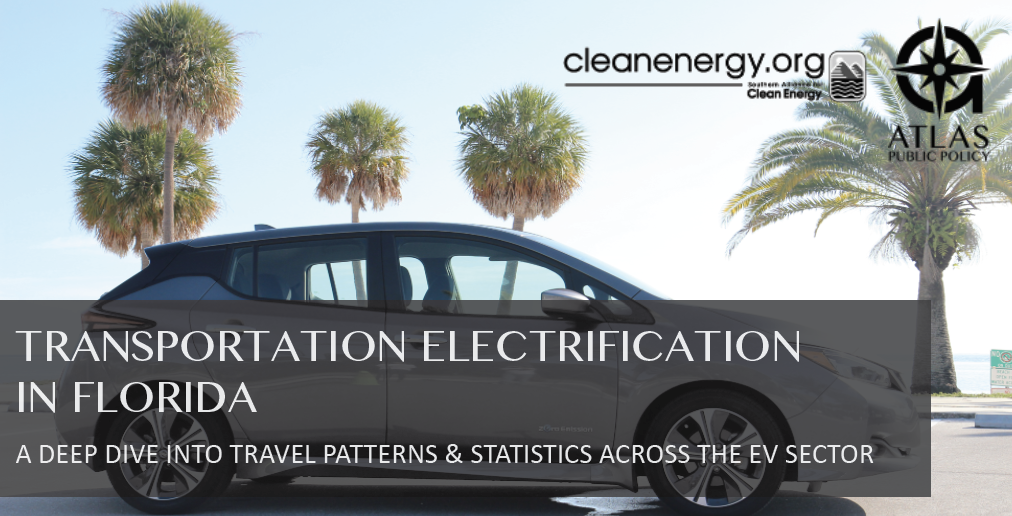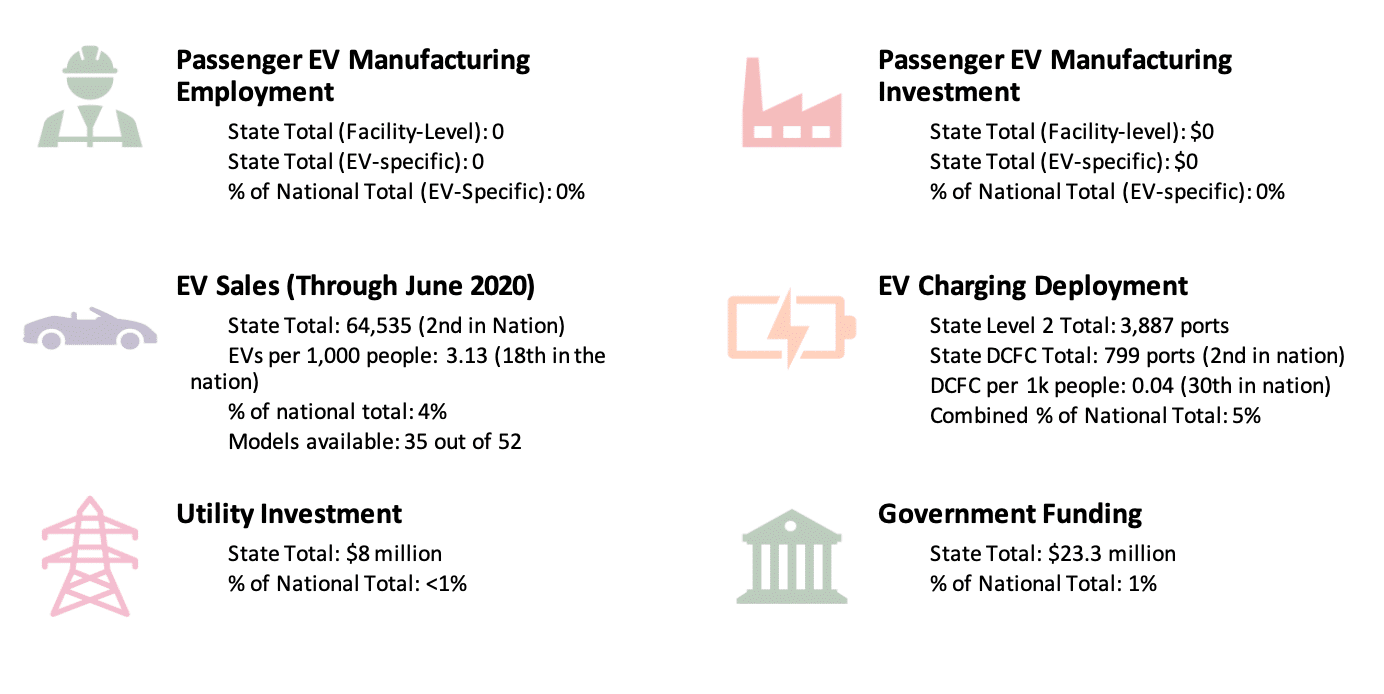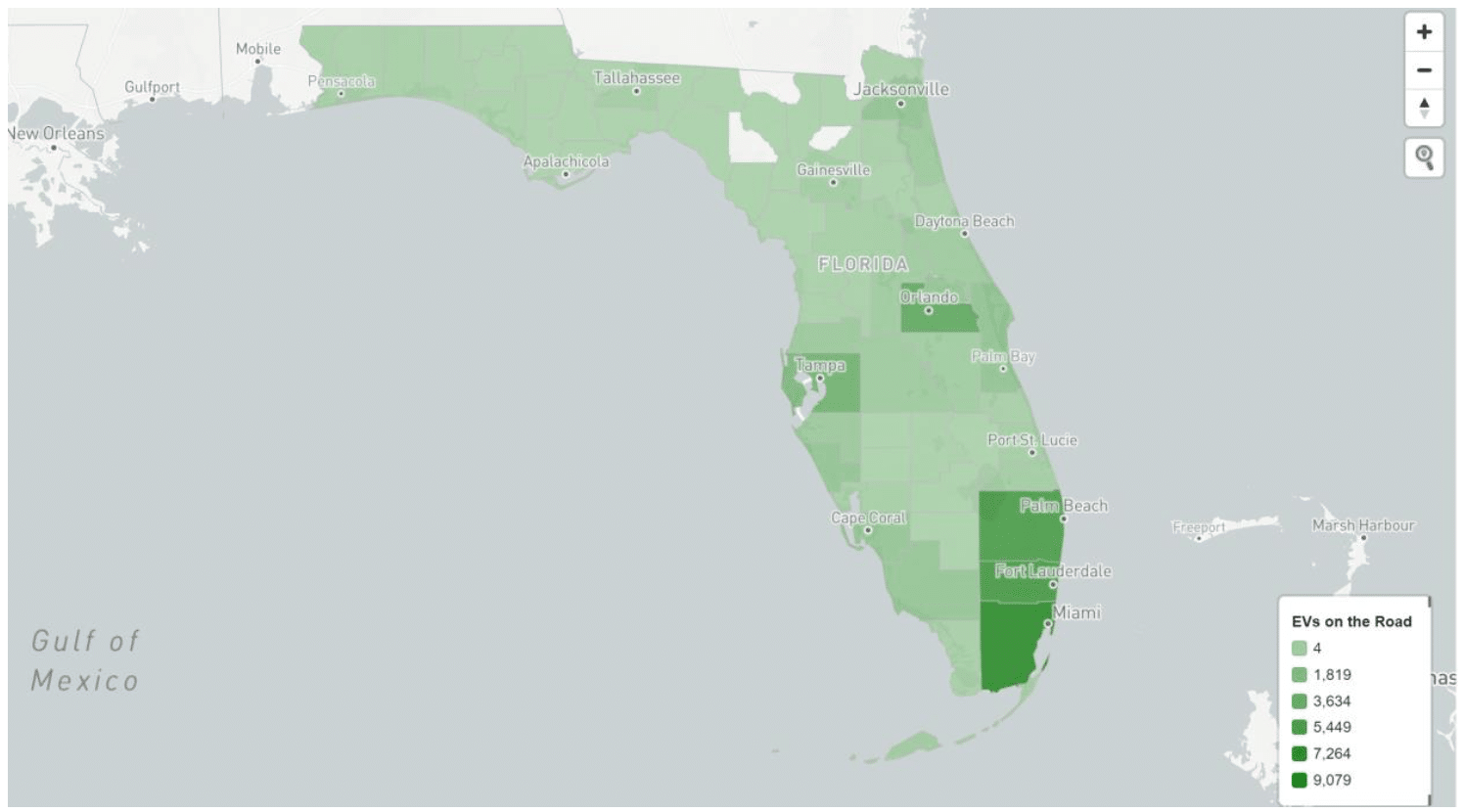Florida is #2 in the nation in electric vehicle (EV) sales, but currently near the bottom in state government policies and investment. State lawmakers can advance policies and direct investment to accelerate the market, enabling all Floridians to access electric transportation and the related economic, public health, and climate benefits.
Stan Cross | October 28, 2020 | Clean Transportation, Electric Vehicles, FloridaStates across the country, including Florida, are seizing opportunities to increase the numbers of electric vehicles (EV) on their roads and the number of EV charging stations available to their drivers. Cumulatively, 1.6 million passenger EVs have been sold nationally, and investment in our country’s EV sector is rising. Transportation electrification is taking hold in the United States across all vehicle types, including consumer vehicles, fleets, electric buses, and trucks.
To explore how Florida stacks up against other states, the Southern Alliance for Clean Energy (SACE) and Atlas Public Policy have collaborated on a new brief, “Transportation Electrification in Florida.” The new brief follows the recent “Transportation Electrification in the Southeast” brief, also a collaboration between SACE and Atlas, that examined state policy, regulatory, economic development, and investment activity across the Southeast. The Florida-specific brief provides a snapshot of Florida’s EV market, transportation patterns, policy environment, and opportunities to improve public health, meet climate change goals, and spur economic growth. This blog is the third and final in a series examining the study’s findings.

Download the Brief
Read the Blog Series
The State of Florida’s EV Market
Florida is #2 in the nation in overall passenger EV sales. As of June 202o, there were roughly 64,500 EVs on Florida’s roads. EV sales in the state increased by 20% between 2018 and 2019, despite a 12% drop in EV sales nationwide during the same period. However, when looked at on a per capita basis, Florida ranks 18th nationally in EV sales. To put things in perspective, California has approximately twice Florida’s population but over ten times the number of EVs showing Florida has significant room for EV growth.
Florida lags other states in government support for transportation electrification and utility investment and ranks 30th in per capita deployment of EV charging infrastructure. Florida also lacks EV manufacturing employment and investment, which are economic opportunities neighboring states are well-positioned to seize.
EV INDICATORS IN FLORIDA THROUGH AUGUST 2020

State Policies Will Drive Florida’s EV Future
When Governor Desantis signed SB 7018, Essential State Infrastructure, into law in June 2020, Florida committed to supporting EV market growth by creating a master plan for charging infrastructure along the state’s interstate corridor system. The law tasks the Florida Department of Transportation (FDOT), Public Service Commission (PSC), and Energy Office to identify barriers and opportunities to advance EV adoption, including state policy and utility engagement recommendations.
Currently, Palm Beach, Broward, and Miami-Dade counties have heavy EV concentrations, with smaller concentrations seen in Tampa Bay and Orlando. The master plan intends to expand EV ownership to all Floridians in all communities across the state by ensuring adequate charging infrastructure to meet daily driving and evacuation needs. Scaling charging station deployment along transportation corridors will also support tourism, one of the state’s primary economic engines. As EV sales grow in the states where Florida’s tourists originate, there will be an ever-increasing number of consumers eager to drive their EVs on vacation.
FLORIDA EV REGISTRATIONS THROUGH JUNE 2020

EV Policy Best Practices are Emerging
Medium and heavy-duty EVs are coming to market, offering new EV fleet applications. Passenger EVs are becoming increasingly more desirable as sticker prices come down, and battery range goes up. Now is the time to implement state policies to ensure consumers and fleet operators can access the economic, public health, and climate benefits EVs deliver — including improved public health, consumer savings, retained wealth, downward pressure on electric utility rates, reduced climate change risk, and increased energy security.
As part of the master plan process, FDOT leads the policy consideration conversation, bringing a range of state, local, and regional recommendations to the table.

Many of the policies listed by FDOT are aligned with policy considerations being implemented successfully in states across the country:
Plan for a Transportation Electrification Future
- Finalize and implement the Florida EV master plan, including setting aggressive EV adoption goals and establishing priorities to guide government, utility, and private sector engagement.
- Work together with other Southeastern states to develop a regional electric transportation initiative similar to REV West. Regional collaboration can increase economic development opportunities, purchase power, and highway corridor charging build-out.
Support Consumer and Fleet Access to the Expanding EV Market
- Join the Multi-State Medium and Heavy-Duty Zero Emission Vehicle (ZEV) Memorandum of Understanding to spur medium and heavy-duty EV market activity as North Carolina did.
- Adopt Light Duty ZEV Standards to open vehicle access to consumers and fleet operators like Minnesota, New Mexico, Nevada, and Ohio that plan to join the other 12 states that have already signed on.
- Institute an EV tax credit or rebate for consumers and private fleet owners like Colorado did.
- Support used car incentives to make EV ownership more accessible to a broader range of consumers, like Oregon’s program targeted at low-to-moderate income communities.
- Encourage the establishment of low-interest loan programs for consumers that include new and used EVs as Washington did.
Electrify State and Municipal Fleets
- Analyze and prioritize state government EV fleet adoption to reduce operation and maintenance expenses and save taxpayers money long-term, like North Carolina already is doing.
- Leverage the remaining $141 million from the Volkswagen Settlement to support transit bus electrification, as Greensboro, North Carolina, and Miami-Dade County, Florida have, and school bus electrification, as Virginia is already doing.
- Lead the Southeast by implementing an electric transition plan for state transit buses and school buses.
Support Increased EV Charger Deployment
- Establish state-wide EV make-ready building codes to reduce EV charging station installation costs and encourage deployment.
- Protect parking spaces equipped with EV chargers from being occupied by non-EVs, as Florida has done, by adding penalties for violators as Arizona did.
- Empower electric utility regulators to determine appropriate principles and guidelines for utility engagement and investment like those suggested by Edison Electric Institute.
SACE celebrates the intent of SB 7018 and will continue to support FDOT, the Florida PSC, and the Energy Office and advocate for an innovative and impactful master plan. Florida is poised to lead the region’s and the nation’s transition to electric transportation. Implementing a master plan that includes supportive state policies and accelerates utility engagement will enable increased charging station deployment, expand consumer access to EVs, and cement Florida’s market leadership.
Check out the other blogs in this series:
Read Part 1, “Transportation Electrification in Florida: Opportunities are Bright, Could Be Brighter,” for an overview of the Transportation Electrification in Florida Brief.
Read Part 2, “Transportation Electrification in Florida: Leveraging Utility Engagement,” which addresses how utility engagement and investment can accelerate Florida’s transition to electric transportation.
The Southern Alliance for Clean Energy’s ‘Electrify the South’ campaign advocates for a shift to clean, electric transportation throughout the Southeast. Visit ElectrifytheSouth.org to learn more and connect with us.
#EVsinFL